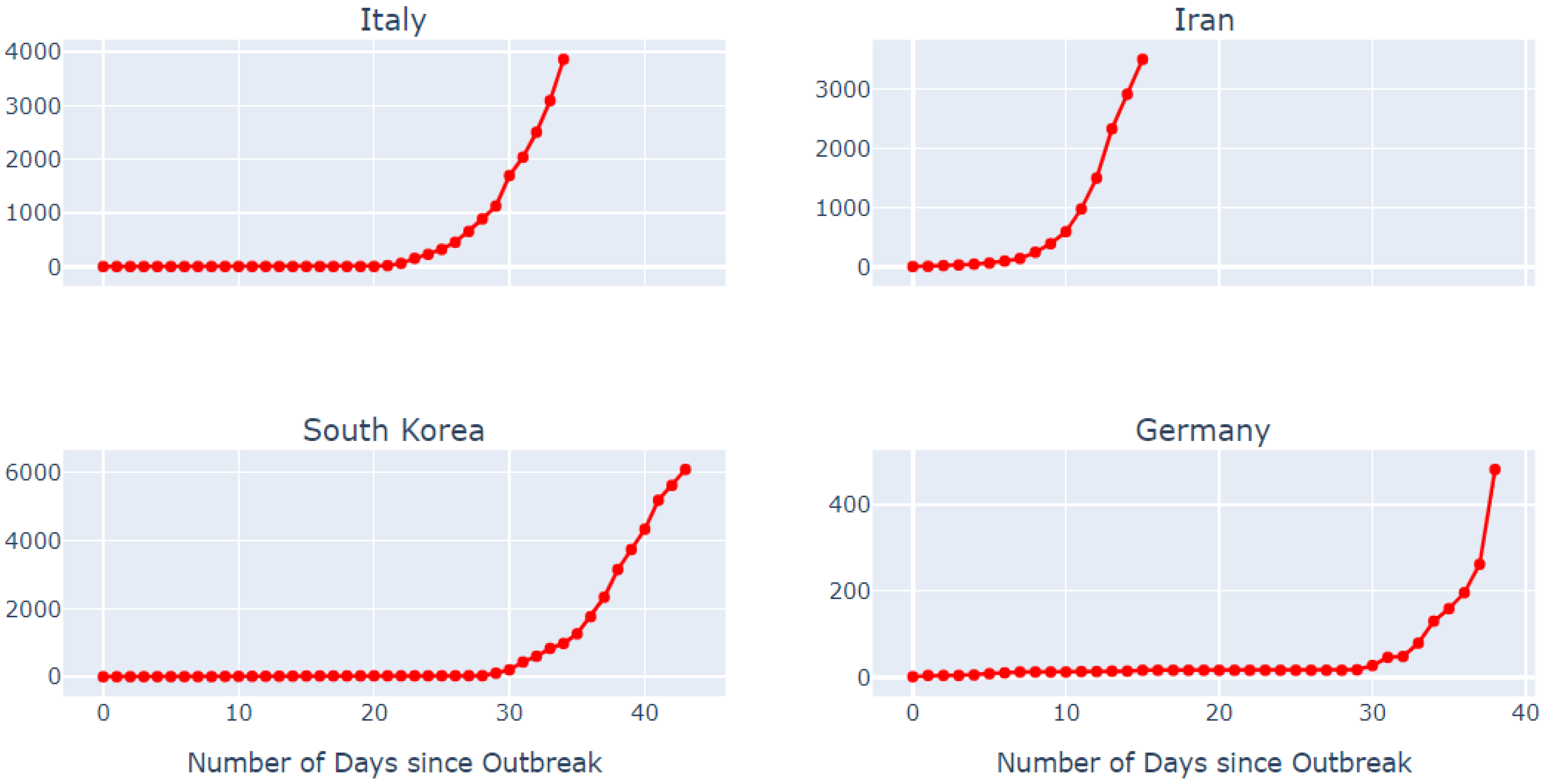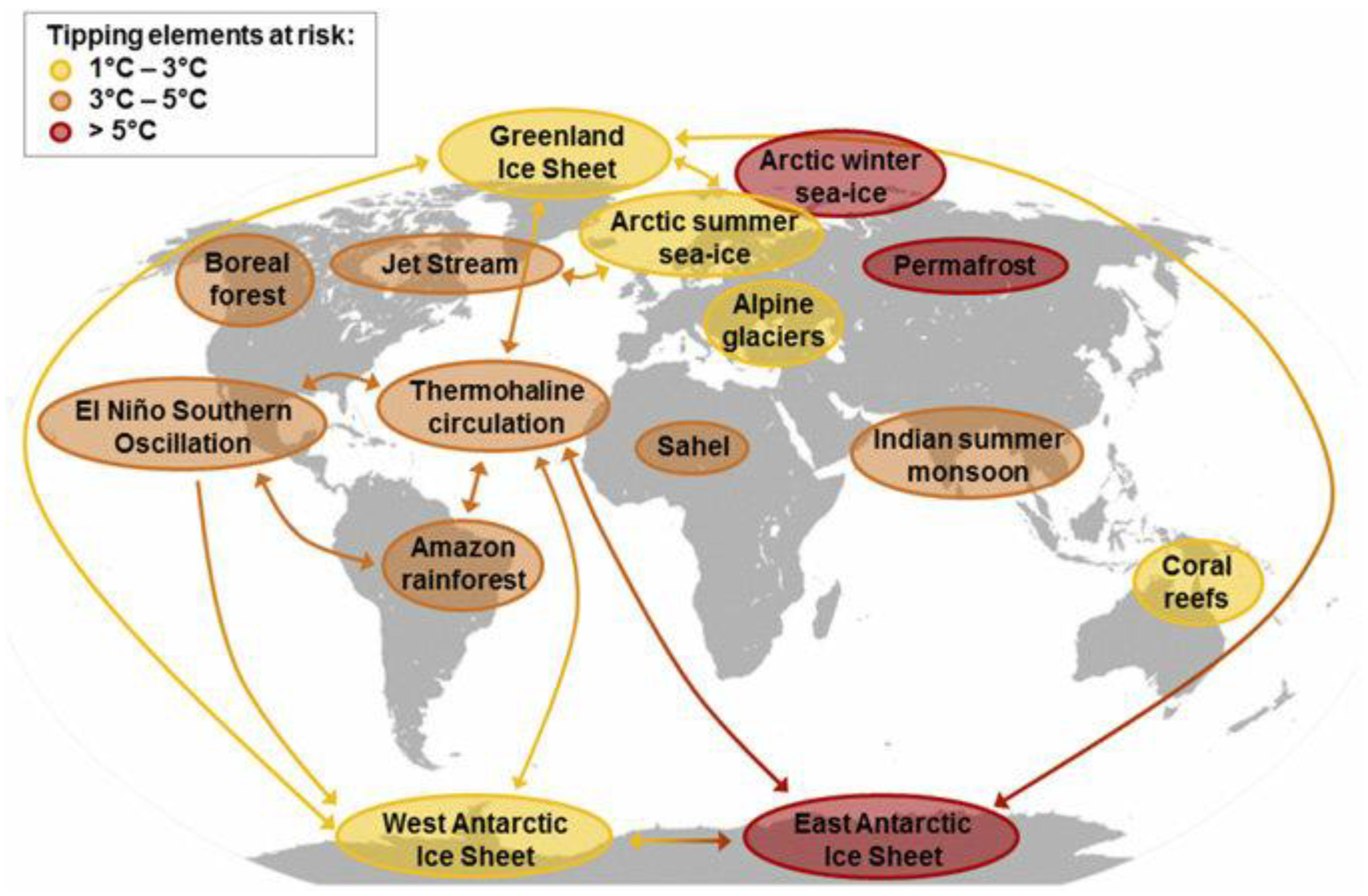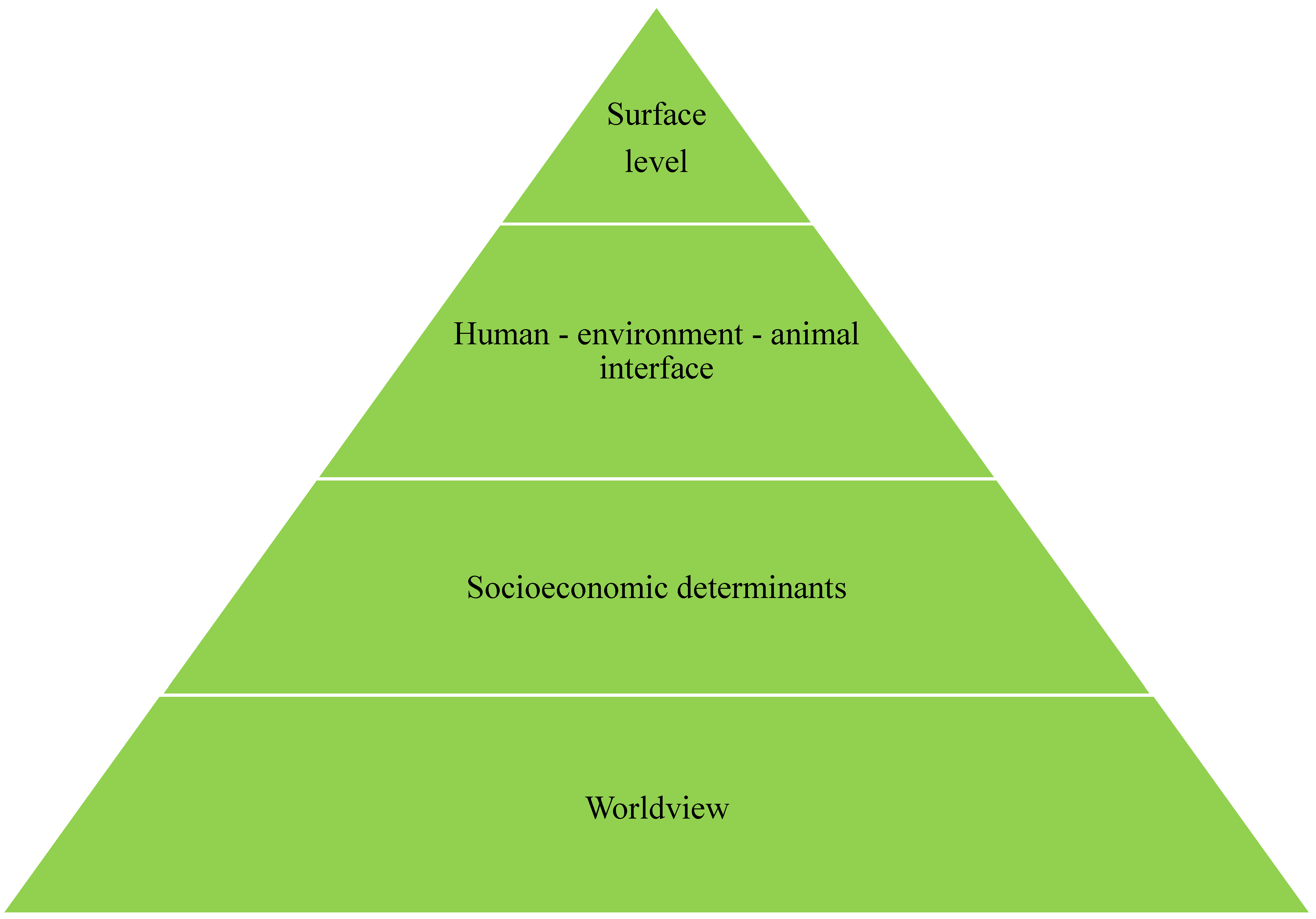The COVID-19 Pandemic and the Climate Crisis: A Call to Question the Mindset of Modernity
Abstract
:1. Introduction
2. Understanding the Crises as Nonlinear Phenomena
2.1. Structural Analogies between the COVID-19 Pandemic and Climate Change
2.2. Complex Thinking for Understanding a Complex Reality
“Since everything is linked up and networked with everything else, a break down anywhere has a knock on effect, unsettling other parts of the network, even bringing down the whole network. Moreover, the potential for positive feedback, for things to multiply rapidly and dangerously in geometric progression, is enormous. This is where those small, insignificant, initial conditions come in: they can trigger major upheavals, even a small change can lead to collapse with accelerating speed. A computer virus, a strike, a single resignation, can set off a chain reaction that can bring a nation or the whole world to a grinding halt”[20], p. 438.
3. How the Crisis Is Framed Matters: The Case of the COVID-19 Pandemic
A Multilevel Analysis of the COVID-19 Pandemic
4. The Common Deeper Root of the Crises: The Worldview Level
4.1. Revitalizing the Disrupted Interconnections and Interdependencies
4.2. Modernists vs. Earthbound People
“Would it be possible to accept the candidacy of those people who claim to be assembled, for instance, by Pachamama, the Earth goddess? May be, if only we could be sure that what passes for a respect for the Earth is not due to their small numbers and to the relative weakness of their technology. None of those so called ‘traditional’ people, the wisdom of which we often admire, is being prepared to scale up their ways of life to the size of the giant technical metropolises in which are now corralled more than half of the human race”[53], p. 128.
5. Conclusions
Funding
Institutional Review Board Statement
Informed Consent Statement
Data Availability Statement
Conflicts of Interest
| 1 | |
| 2 | Scientists’ heightened awareness of the magnitude of the environmental crisis is reflected in the 2001 Amsterdam Declaration on Earth System Science: “Earth System dynamics are characterized by critical thresholds and abrupt changes. Human activities could inadvertently trigger such changes with severe consequences for Earth’s environment and inhabitants. The Earth System has operated in different states over the last half million years, with abrupt transitions (a decade or less) sometimes occurring between them. Human activities have the potential to switch the Earth System to alternative modes of operation that may prove irreversible and less hospitable to humans and other life (…) In terms of some key environmental parameters, the Earth System has moved well outside the range of the natural variability exhibited over the last half million years at least. The nature of changes now occurring simultaneously in the Earth System, their magnitudes and rates of change are unprecedented. The Earth is currently operating in a no-analogue state” [62]. |
| 3 | A scheme like this is, of course, a simplification. It aims to provide a conceptual standpoint to highlight that the reasons of complex crises reside at multiple levels. A (readjusted) multilayered scheme could be used to frame the climate crisis too. In this case, even situations at the surface level risk not being perceived with the same sense of urgency, due to the much slower moving rate of climate change. More generally speaking, it would be also important to cross-check analyses of this sort with alternative perspectives. For instance, the historian Dipesh Chakrabarty warned about the necessity to distinguish between the point of view of global history and that of deep planetary history: whereas the former refers to the role played by humans, the latter corresponds to the geobiological history of the planet, which has a totally different temporal scale—perhaps millions of years—and exceeds human agency. Chakrabarty specifically focused on climate change [63], arguing that its history cannot be reduced to the impacts of capitalism and globalization, and their intensive use of fossil fuels. We should also frame it with reference to the deep history of the Earth, including the history of the human species and the biological and cultural transformations that have led to its development. He applied a similar reasoning to the COVID-19 pandemic situation too [64]. When we consider the contingent conditions that have led to the pandemic, e.g., invasive anthropic activities, humans as the vector for virus spreading, worldwide interconnectedness, we are using the point of view of global history. When we instead consider the fact that SARS-CoV-2, as well as other coronavirus of mammalian species, could be pre-adapted to human infectivity [65,66]—and that human bodies have become part of its evolutionary pathways—we are using the perspective of planetary history. |
References
- Shepherd, A.; Ivins, E.; Rignot, E.; Smith, B.; van den Broeke, M.; Velicogna, I.; Whitehouse, P.; Briggs, K.; Joughin, I.; Krinner, G.; et al. Mass balance of the Greenland ice sheet from 1992 to 2018. Nature 2020, 579, 233–239. [Google Scholar]
- Bellard, C.; Bertelsmeier, C.; Leadley, P.; Thuiller, W.; Courchamp, F. Impacts of climate change on the future of biodiversity. Ecol. Lett. 2012, 15, 365–377. [Google Scholar] [CrossRef] [PubMed] [Green Version]
- National Academy of Sciences. Climate Change and Ecosystems; The National Academies Press: Washington, DC, USA, 2019. [Google Scholar]
- Frumkin, H.; Haines, A. Global environmental change and noncommunicable disease risks. Annu. Rev. Public Health 2019, 40, 261–282. [Google Scholar] [CrossRef] [PubMed] [Green Version]
- WHO. Health and Environment in Europe: Progress in Assessment; WHO Regional Office for Europe: Copenhagen, Denmark, 2010. [Google Scholar]
- Pasini, A.; Mazzocchi, F. Perception and risk of COVID-19 and climate change: Investigating analogies in a common framework. Glob. Sustain. 2020, 3, e32. [Google Scholar] [CrossRef]
- Vinke, K.; Gabrysch, S.; Paoletti, E.; Rockström, J.; Schellnhuber, H.J. Corona and the climate: A comparison of two emergencies. Glob. Sustain. 2020, 3, e25. [Google Scholar] [CrossRef]
- Scheffer, M. Critical Transitions in Nature and Society; Princeton University Press: Princeton, NJ, USA, 2009. [Google Scholar]
- Norman, J.; Bar-Yam, Y.; Taleb, N.N. Systemic Risk of Pandemic via Novel Pathogens—Coronavirus: A Note. NECSI, 26 January 2020. Available online: https://necsi.edu/systemic-risk-of-pandemic-via-novel-pathogens-coronavirus-a-note (accessed on 25 February 2022).
- Nature editorial. Coronavirus: Three things all governments and their science advisers must do now. Nature 2020, 579, 319–320. [Google Scholar] [CrossRef] [Green Version]
- Solly, M. Carbon Dioxide Levels Reach Highest Point in Human History. Smithsonian Magazine, 15 May 2019. Available online: https://www.smithsonianmag.com/smartnews/carbon-dioxide-levels-reach-highest-point-humanhistory-180972181/ (accessed on 1 March 2022).
- Steffen, W.; Rockström, J.; Richardson, K.; Lenton, T.M.; Folke, C.; Liverman, D.; Summerhayes, C.P.; Barnosky, A.D.; Cornell, S.E.; Crucifix, M.; et al. Trajectories of the Earth system in the Anthropocene. Proc. Natl. Acad. Sci. USA 2018, 115, 8252–8259. [Google Scholar] [CrossRef] [Green Version]
- Lenton, T.M.; Rockström, J.; Gaffney, O.; Rahmstorf, S.; Richardson, K.; Steffen, W.; Schellnhuber, H.J. Climate tipping points—Too risky to bet against. Nature 2019, 575, 592–595. [Google Scholar] [CrossRef]
- Barrett, S.; Lenton, T.M.; Millner, A.; Tavoni, A.; Carpenter, S.; Anderies, J.M.; Chapin, F.S., III; Crépin, A.-S.; Daily, G.; Ehrlich, P.; et al. Climate engineering reconsidered. Nat. Clim. Chang. 2014, 4, 527–529. [Google Scholar] [CrossRef]
- Griscom, B.W.; Adams, J.; Ellis, P.W.; Houghton, R.A.; Lomax, G.; Miteva, D.A.; Schlesinger, W.H.; Shoch, D.; Siikamäki, J.V.; Smith, P.; et al. Natural climate solutions. Proc. Natl. Acad. Sci. USA 2017, 114, 11645–11650. [Google Scholar] [CrossRef] [Green Version]
- Rockström, J.; Gaffney, O.; Rogelj, J.; Meinshausen, M.; Nakicenovic, N.; Schellnhuber, H.J. A roadmap for rapid decarbonization. Science 2017, 355, 1269–1271. [Google Scholar] [CrossRef] [PubMed] [Green Version]
- Horn, E. Tipping points: The Anthropocene and COVID-19. In Pandemics, Politics, and Society. Critical Perspectives on the COVID-19 Crisis; Delanty, G., Ed.; Alter de Gruyter GmbH: Berlin, Germany, 2021; pp. 123–137. [Google Scholar]
- Morin, E. La Méthode 3. La Connaissance de la Connaissance; Editions du Seuil: Paris, France, 1986. [Google Scholar]
- Morin, E. La Méthode 4. Les idées. Leur Habitat, Leur vie, Leurs Moeurs, Leur Organization; Editions du Seuil: Paris, France, 1986. [Google Scholar]
- Sardar, Z. Welcome to postnormal times. Futures 2010, 42, 435–444. [Google Scholar] [CrossRef]
- McNeill, W.H. Plagues and Peoples; Anchor Books: New York, NY, USA, 1976. [Google Scholar]
- Roy, A. Arundhati Roy: ‘The Pandemic Is a Portal’. Financial Times, 3 April 2020. Available online: https://www.ft.com/content/10d8f5e8-74eb-11ea-95fe-fcd274e920ca (accessed on 3 March 2022).
- Mormina, M.; Schöneberg, J.; Narayanaswamy, L. Knowledge and Science Advice during and after COVID-19: Re-Imagining Notions of ‘Expertise’ for Postnormal Times. SSRN, 22 December 2020. Available online: https://www.ethox.ox.ac.uk/publications/1178637?fdabf41a-0986-11ed-b826-061588ba0eaa (accessed on 3 March 2022).
- Pope-Francis. Fratelli Tutti (on Fraternity and Social Friendship). Vatican Archives, 2020. Available online: http://www.vatican.va/content/francesco/en/encyclicals/documents/papa-francesco_20201003_enciclica-fratelli-tutti.html (accessed on 3 March 2022).
- Beer, F.A.; Hariman, R. Learning from the pandemic: Catastrophic epistemology. Soc. Epistemol. Rev. Reply Collect. 2020, 9, 19–28. Available online: https://wp.me/P1Bfg0-4Wa (accessed on 2 March 2022).
- Mazzocchi, F. What means to be interconnected at the time of COVID-19 pandemic: Regaining the sense of community. J. Futures Stud. 2021, 25, 39–48. [Google Scholar]
- Carrington, D. Pandemics Result from Destruction of Nature, Say UN and WHO. The Guardian, 17 June 2020. Available online: https://www.theguardian.com/world/2020/jun/17/pandemics-destruction-nature-un-who-legislation-trade-green-recovery (accessed on 2 March 2022).
- Morens, D.M.; Fauci, A.S. Emerging pandemic diseases: How we got to COVID-19. Cell 2020, 182, 1077–1092. [Google Scholar] [CrossRef]
- Mazzocchi, F. Tackling modern-day crises: Why understanding multilevel interconnectivity is vital. Bioessays 2021, 43, 2000294. [Google Scholar] [CrossRef]
- Bonilla-Aldana, D.K.; Dhama, K.; Rodriguez-Morales, A.J. Revisiting the one health approach in the context of COVID-19: A look into the ecology of this emerging disease. Adv. Anim. Vet. Sci. 2020, 8, 234–237. [Google Scholar] [CrossRef] [Green Version]
- Afelt, A.; Frutos, R.; Deveaux, C. Bats, coronaviruses, and deforestation: Toward the emergence of infectious diseases? Front. Microbiol. 2018, 9, 702. [Google Scholar] [CrossRef] [Green Version]
- Allen, T.; Murray, K.A.; Zambrana-Torrelio, C.; Morse, S.S.; Rondinini, C.; Di Marco, M.; Breit, N.; Olival, K.J.; Daszak, P. Global hotspots and correlates of emerging zoonotic diseases. Nat. Commun. 2017, 8, 1124. [Google Scholar] [CrossRef]
- Lloyd-Smith, J.O.; George, D.; Pepin, K.M.; Pitzer, V.E.; Pulliam, J.R.C.; Dobson, A.P.; Hudson, P.J.; Grenfell, B.T. Epidemic dynamics at the human-animal interface. Science 2009, 326, 1362–1367. [Google Scholar] [CrossRef] [Green Version]
- Morens, D.M.; Daszak, P.; Taubenberger, J.K. Escaping Pandora’s box—Another novel coronavirus. N. Engl. J. Med. 2020, 382, 1293–1295. [Google Scholar] [CrossRef] [PubMed]
- Jones, B.A.; Grace, D.; Kock, R.; Alonso, S.; Rushton, J.; Said, M.Y.; McKeever, D.; Mutua, F.; Young, J.; John McDermott, J.; et al. Zoonosis emergence linked to agricultural intensification and environmental change. Proc. Natl. Acad. Sci. USA 2013, 110, 8399–8404. [Google Scholar] [CrossRef] [PubMed] [Green Version]
- Wallace, R.; Holmberg, M. The dawn of structural one health: A new science tracking disease emergence along circuits of capital. Soc. Sci. Med. 2015, 129, 68–77. [Google Scholar] [CrossRef] [PubMed]
- Schrecker, T. Neoliberalism and health: The linkages and the dangers. Sociol. Compass 2016, 10, 952–971. [Google Scholar] [CrossRef] [Green Version]
- Stengers, I. In Catastrophic Times: Resisting the Coming Barbarism; Open Humanities Press: London, UK, 2015. [Google Scholar]
- Descartes, R. Discourse on Method; Bobbs–Merril: NewYork, NY, USA, 1950. [Google Scholar]
- Mazzocchi, F. A deeper meaning of sustainability: Insights from indigenous knowledge. Anthr. Rev. 2020, 7, 77–93. [Google Scholar] [CrossRef]
- Varela, F.J. Principles of Biological Autonomy; Elsevier North Holland: New York, NY, USA, 1979. [Google Scholar]
- Mazzocchi, F. Complexity and the mind-nature divide. World Futures 2016, 72, 353–368. [Google Scholar] [CrossRef]
- Chuwa, L. African Indigenous Ethics in Global Bioethics: Interpreting Ubuntu; Springer: Dordrecht, The Netherlands, 2014. [Google Scholar]
- Eze, M.O. I am because you are: Cosmopolitanism in the age of xenophobia. Philos. Pap. 2017, 46, 85–109. [Google Scholar] [CrossRef]
- Haila, Y. Beyond the nature-culture dualism. Biol. Philos. 2000, 15, 155–175. [Google Scholar] [CrossRef]
- Commoner, B. The Closing Circle: Nature, Man, and Technology; Alfred A. Knopf: New York, NY, USA, 1971. [Google Scholar]
- Bateson, G. Mind and Nature: A Necessary Unity; Bantam Books: New York, NY, USA, 1980. [Google Scholar]
- Holm, N.; Taffel, S. (Eds.) Ecological Entanglements in the Anthropocene; Lexington Books: Lanham, MD, USA, 2017. [Google Scholar]
- Maffesoli, M. Écosophie: Une écologie Pour Notre Temps; Cerf: Paris, France, 2017. [Google Scholar]
- Morton, T. The Ecological Thought; Harvard University Press: Cambridge, MA, USA, 2010. [Google Scholar]
- Haraway, D.J. Primate Visions: Gender, Race, and Nature in the World of Modern Science; Verso: London, UK, 1992. [Google Scholar]
- Hekman, S. Gender and Knowledge: Elements of a Postmodern Feminism; Northeastern University Press: Boston, MA, USA, 1990. [Google Scholar]
- Latour, B. Facing Gaia: Six Lectures on the Political Theology of Nature. Being the Gifford Lectures on Natural Religion, Edinburgh, 18 th–28 th of February 2013. Available online: https://eportfolios.macaulay.cuny.edu/wakefield15/files/2015/01/LATOUR-GIFFORD-SIX-LECTURES_1.pdf (accessed on 7 June 2022).
- Abson, D.J.; Fischer, J.; Leventon, J.; Newig, J.; Schomerus, T.; Vilsmaier, U.; von Wehrden, H.; Abernethy, P.; Ives, C.D.; Jager, N.W.; et al. Leverage points for sustainability transformation. AMBIO 2017, 46, 30–39. [Google Scholar] [CrossRef] [Green Version]
- Riechers, M.; Balázsi, A.; García-Llorente, M.; Loos, J. Human-nature connectedness as leverage point. Ecosyst People 2021, 17, 215–221. [Google Scholar] [CrossRef]
- Escobar, A. Pluriversal Politics: The Real and the Possible; Duke University Press: Durham, NC, USA, 2020. [Google Scholar]
- McGregor, D. Coming full circle: Indigenous knowledge, environment, and our future. Am. Indian Q. 2004, 28, 385410. [Google Scholar] [CrossRef]
- Puhakka, K. Intimacy, otherness, and alienation: The intertwining of nature and consciousness. In Ecopsychology, Phenomenology, and the Environment: The Experience of Nature; Vakoch, D.A., Castrillón, F., Eds.; Springer: New York, NY, USA, 2014; pp. 11–26. [Google Scholar]
- Whyte, K.P.; Cuomo, C. Ethics of caring in environmental ethics: Indigenous and feminist philosophies. In The Oxford Handbook of Environmental Ethics; Gardiner, S.M., Thompson, A., Eds.; Oxford University Press: Oxford, UK, 2016; pp. 234–247. [Google Scholar]
- Mazzocchi, F. Why ‘integrating’ Western science and indigenous knowledge is not an easy task: What lessons could be learned for the future of knowledge? J. Futures Stud. 2018, 22, 19–34. [Google Scholar]
- IPCC. Climate Change 2013: The Physical Science Basis; Cambridge University Press: Cambridge, UK, 2013. [Google Scholar]
- Moore, B., III; Underdal, A.; Lemke, P.; Loreau, M. 2001 Amsterdam Declaration on Earth System Science. Available online: http://www.igbp.net/about/history/2001amsterdamdeclarationonearthsystemscience.4.1b8ae20512db692f2a680001312.html (accessed on 7 March 2022).
- Chakrabarty, D. The climate of history: Four theses. Crit. Inq. 2009, 35, 197–222. [Google Scholar] [CrossRef]
- Chakrabarty, D. An Era of Pandemics? What is Global and What is Planetary about COVID-19. Critical Inquiry: In the Moment, 16 October 2020. Available online: https://critinq.wordpress.com/2020/10/16/an-era-of-pandemics-what-is-global-and-what-is-planetary-about-covid-19/ (accessed on 12 June 2022).
- Andersen, K.G.; Rambaut, A.; Lipkin, W.I.; Holmes, E.C.; Garry, R.F. The proximal origin of SARS-CoV-2. Nat. Med. 2020, 26, 450–452. [Google Scholar] [CrossRef] [PubMed] [Green Version]
- Hu, B.; Zeng, L.P.; Yang, X.L.; Ge, X.Y.; Zhang, W.; Li, B.; Xie, J.Z.; Shen, X.R.; Zhang, Y.Z.; Wang, N.; et al. Discovery of a rich gene pool of bat SARS-related coronaviruses provides new insights into the origin of SARS coronavirus. PLoS Pathog. 2017, 13, e1006698. [Google Scholar] [CrossRef] [PubMed]



Publisher’s Note: MDPI stays neutral with regard to jurisdictional claims in published maps and institutional affiliations. |
© 2022 by the author. Licensee MDPI, Basel, Switzerland. This article is an open access article distributed under the terms and conditions of the Creative Commons Attribution (CC BY) license (https://creativecommons.org/licenses/by/4.0/).
Share and Cite
Mazzocchi, F. The COVID-19 Pandemic and the Climate Crisis: A Call to Question the Mindset of Modernity. Challenges 2022, 13, 33. https://doi.org/10.3390/challe13020033
Mazzocchi F. The COVID-19 Pandemic and the Climate Crisis: A Call to Question the Mindset of Modernity. Challenges. 2022; 13(2):33. https://doi.org/10.3390/challe13020033
Chicago/Turabian StyleMazzocchi, Fulvio. 2022. "The COVID-19 Pandemic and the Climate Crisis: A Call to Question the Mindset of Modernity" Challenges 13, no. 2: 33. https://doi.org/10.3390/challe13020033
APA StyleMazzocchi, F. (2022). The COVID-19 Pandemic and the Climate Crisis: A Call to Question the Mindset of Modernity. Challenges, 13(2), 33. https://doi.org/10.3390/challe13020033





